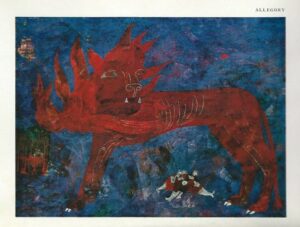
I haven’t posted for a couple of weeks. I am finding that consistent blog posting is a big commitment of time and thought, unless you are willing to settle for post just for the sake of a post. I have been thinking a lot about what to say about my work and my thought process and I keep coming back to an essay by Ben Shahn. He describes in a book of essays “The Shape of Content” about how he developed a painting entitled “Allegory”. The basis for the painting was about a man in Chicago who lost his 4 children in a tragic fire. An art critic whom Shahn felt liked his work and had written positively about his work in the past wrote a scathing critique on the painting accusing Shahn of a political agenda and suggesting he be deported. Surprised at this response, Shahn revisits the painting and its pieces,symbols and meaning. How did this painting provoke such a response? What symbols and imagery go into the meaning of an artistic work on the conscious and unconscious level? As a boy, Shahn had some experience with fires. He was present when his grandfathers little Russian village burned. He remembered the excitement, the flames breaking out and the bucket brigades working to extinguish the fire. His father was badly scarred by fire when he climbed a drain pipe to rescue him and his siblings.
That is the back story. The part that I found personal and compelling in the essay was when he talks about the artist being 2 individuals; the artist or creator and the critic or judge. The artist imagines an idea, an image to explore. Even at this early stage the critic has begun tearing it down with criticism and doubt. You are not good enough. The idea is underdeveloped. You must find better symbols, better skill, a better idea. The internal critic has extremely high standards, and often unreasonable expectations. These 2 individuals that exist in each of us, even those not in the arts must be somehow balanced to allow us to move forward rather than paralyze our creativity and abilities. I too often find that the critic is too loud and becomes the dominant voice in my head.
The balancing voices I try to practice are the ones that admonish, “it is what it is” or “this is not the important image, but it is the next one that is important and you must pass through this one to get there.” My imagery right now is stalled in time commitments and more importantly in the voice of the critic expressing doubts. I do know that I will overcome the critic and that the ensuing image will be meaningful at least to me. After all it is what it is.